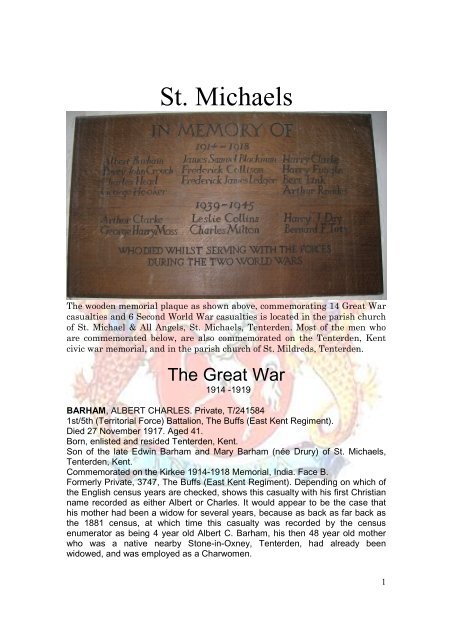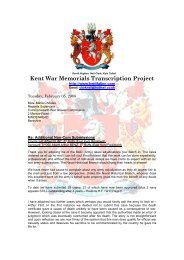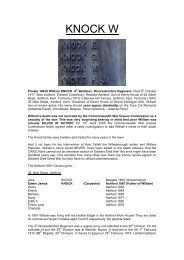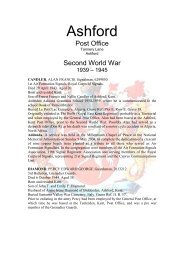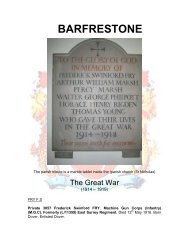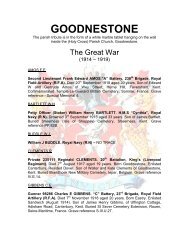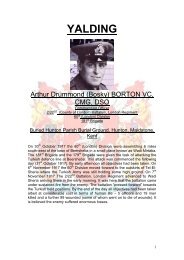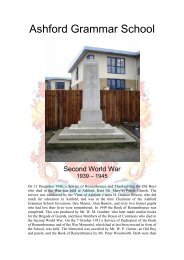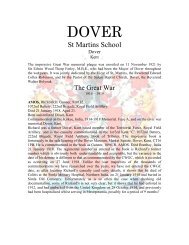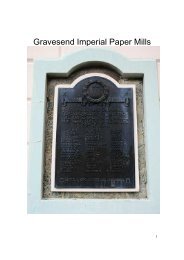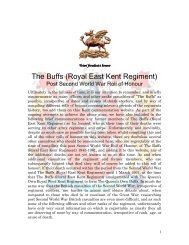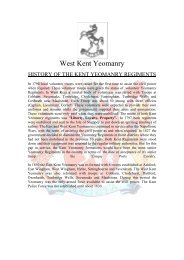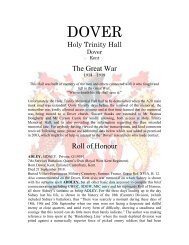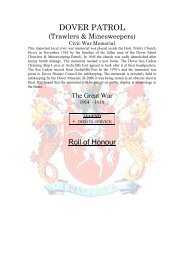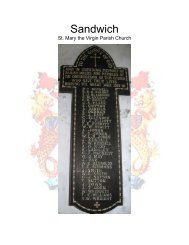Create successful ePaper yourself
Turn your PDF publications into a flip-book with our unique Google optimized e-Paper software.
St. Michaels<br />
The wooden memorial plaque as shown above, commemorating 14 Great War<br />
casualties and 6 Second World War casualties is located in the parish church<br />
of St. Michael & All Angels, St. Michaels, Tenterden. Most of the men who<br />
are commemorated below, are also commemorated on the Tenterden, <strong>Kent</strong><br />
civic war memorial, and in the parish church of St. Mildreds, Tenterden.<br />
The Great War<br />
1914 -1919<br />
BARHAM, ALBERT CHARLES. Private, T/241584<br />
1st/5th (Territorial Force) Battalion, The Buffs (East <strong>Kent</strong> Regiment).<br />
Died 27 November 1917. Aged 41.<br />
Born, enlisted and resided Tenterden, <strong>Kent</strong>.<br />
Son of the late Edwin Barham and Mary Barham (née Drury) of St. Michaels,<br />
Tenterden, <strong>Kent</strong>.<br />
Commemorated on the Kirkee 1914-1918 Memorial, India. Face B.<br />
Formerly Private, 3747, The Buffs (East <strong>Kent</strong> Regiment). Depending on which of<br />
the English census years are checked, shows this casualty with his first Christian<br />
name recorded as either Albert or Charles. It would appear to be the case that<br />
his mother had been a widow for several years, because as back as far back as<br />
the 1881 census, at which time this casualty was recorded by the census<br />
enumerator as being 4 year old Albert C. Barham, his then 48 year old mother<br />
who was a native nearby Stone-in-Oxney, Tenterden, had already been<br />
widowed, and was employed as a Charwomen.<br />
1
BLACKMAN, JAMES SAMUEL. Private, T/240257.<br />
5th (Territorial Force) Battalion, The Buffs (East <strong>Kent</strong> Regiment).<br />
Died Friday 21 January 1916. Aged 32.<br />
Born St. Michaels, Tenterden, <strong>Kent</strong>. Enlisted and resided Tenterden, <strong>Kent</strong>.<br />
Son of Mrs. Ann Blackman and of the late Sims Blackman of St. Michaels,<br />
Tenterden, <strong>Kent</strong>.<br />
Commemorated on the Basra Memorial, Iraq. Panel 6.<br />
James’s birth was registered in the Tenterden, <strong>Kent</strong>, Registration District during<br />
the second quarter of 1893. At the time of the 1901 census, the Blackman family<br />
resided at St. Michaels, Tenterden, <strong>Kent</strong>. Head of the house was 61 year old<br />
Tenterden, <strong>Kent</strong> native Sims Blackman who was employed as a Road Labourer.<br />
Aged 17, James was recorded by the census enumerator as being employed as<br />
a Farm Labourer. Unfortunately the actual address of where the Blackman family<br />
resided was not recorded on the 1901 census, but on the 1891 census and<br />
although again it too is not showing an actual address, the family is shown as<br />
residing at Ashford Road West, which is probably also where they were living in<br />
1901. James was numbered amongst the dozen other ranks serving in his<br />
battalion who died on Friday 21 January 1916, whilst the battalion was fighting its<br />
way towards the besieged forces at Kut. Due to the surrounding terrain which<br />
was for the most part marshes, of necessity the relief force was obliged to take<br />
the only viable route open to it, which was via the river Tigris. As the relief force<br />
made its way slowly towards Kut, it had to contend with a number of well<br />
prepared Turkish positions, in addition to what could best be described as<br />
skirmishes. Also hampering the force trying to get to Kut was the prevailing<br />
weather conditions, which at the time of James’s death was heavy and<br />
unrelenting rain, combined with high winds. During the arduous journey towards<br />
Kut, as well as the officers and other ranks that died as the result of fighting the<br />
soldiers of the Ottoman Empire, a not insignificant number of deaths were due to<br />
disease and illness. It would seem likely that James’s grave was not recovered<br />
post Armistice, as some of those who fell with him are at rest at Amara War<br />
Cemetery, Iraq, which contains 4,621 burials of the Great War, more than 3,000<br />
of which were brought into the cemetery after the Armistice.<br />
2
CLARKE, HARRY GEORGE. Private, 144645.<br />
38th Battalion, Canadian Infantry (Eastern Ontario Regiment).<br />
Died 13 January 1918.<br />
Born Tenterden, <strong>Kent</strong>.<br />
Son of Harriett H. Clarke of 14, St. Michaels Terrace, Tenterden, <strong>Kent</strong>, and of the<br />
late Thomas Clarke.<br />
Buried Aubigny Communal Cemetery Extension, Aubigny-en-Artois, Pas de<br />
Calais, France. Grave Ref: III. C. 14.<br />
Commemorated on page 385 of the Canadian First World War Book of<br />
Remembrance.<br />
Harry enlisted in the Canadian Expeditionary Force at Smiths Falls, Ontario,<br />
Canada on 24 July 1915. At the time of his enlistment, Harry stated that he was<br />
3
employed as a Labourer, and named his father Thomas Clarke of St. Michaels,<br />
Tenterden, <strong>Kent</strong> as his next of kin. He also stated that his date of birth was 4<br />
August 1891 which was not correct, as at the time of the 1891 English census<br />
which was carried out on the night of 5 April; Harry was recorded by the census<br />
enumerator as being 8 months old. The Clarke family was residing at Finchden<br />
Cottages, Tenterden, <strong>Kent</strong>. Head of the house was 42 year old Tenterden, <strong>Kent</strong><br />
native Thomas Clarke, who was employed as a Domestic Gardener. A number of<br />
Harry’s brothers had also served in the British army having enlisted prior to the<br />
Great War whilst residing at 14, St. Michaels Terrace, Tenterden, including<br />
Ernest who served as a Corporal in the Army Service Corps, and Frank who<br />
served as a Private in The Buffs (East <strong>Kent</strong> Regiment).<br />
CROUCH, PERCY JOHN. Private, L/8284.<br />
1st Battalion, Queen's Own (Royal West <strong>Kent</strong> Regiment).<br />
Died 24 October 1914. Aged 28.<br />
Born Brightling, Heathfield, Sussex. Enlisted Maidstone, <strong>Kent</strong>. Resided St.<br />
Michaels, Tenterden, <strong>Kent</strong>.<br />
Son of Frederick Crouch and Sarah Crouch of Ashford Road, St. Michaels,<br />
Tenterden, <strong>Kent</strong>.<br />
Commemorated on the Le Touret Memorial, Le Touret Military Cemetery, Pas de<br />
Calais, France. Panel 30.<br />
At the time of the 1901 census, the Crouch family resided at Durrant Green, High<br />
Halden, Ashford, <strong>Kent</strong>. Head of the house was Heathfield, Sussex native<br />
Frederick Crouch who was a Farmer and Dealer. Then aged 15, Percy was<br />
recorded by the census enumerator as being employed as an Agricultural<br />
Labourer. The L prefix on his army number shows that Percy was a serving as a<br />
regular soldier, unfortunately it has not been possible to locate his service<br />
papers, but his regimental number is indicative of him having originally enlisted in<br />
the Queen's Own (Royal West <strong>Kent</strong> Regiment) in late 1906 or early 1907. His<br />
medal index card entry shows that he served in France from 15 August 1914.<br />
Percy was numbered amongst the 15 other ranks in his battalion who died on 24<br />
October 1914. During the night of 23/24 October, Percy’s battalion withdrew from<br />
trenches near the village of Lorgies 12 miles to the north-east of Béthune, and<br />
moved to positions north-east of Neuve Chapelle. The line which was held by the<br />
battalion was between La Bassée and Lorgies roads. Throughout the day the<br />
battalion was subjected to fire from German 6 inch howitzers which were<br />
nicknamed ‘Black Marias.’ In addition to the howitzers, the enemy also deployed<br />
three or field guns against the battalion, as well as rifles and machine guns.<br />
Various commentators who were actually there, later made similar comments<br />
along the lines that the battalion coped with the shrapnel and machine gun fire,<br />
mainly due to the fact that the fire trenches, and especially the supports in dugouts<br />
which it occupied, were in a broad ditch some 15 feet wide and 8 feet deep.<br />
The ‘Black Marias’ the battalion had nothing to counter, with a very steep angle<br />
of descent the shells wrecked everything they hit, making hole 6 feet deep and 8<br />
feet across in the soft soil. It would seem likely that it was probably one of the<br />
German 6 inch howitzer shells which actually caused Percy’s death.<br />
4
COLLISON, FREDERICK. Private, G/67428.<br />
6th (Service) Battalion, The Queen's (Royal West Surrey Regiment).<br />
Died 20 June 1916 or 20 June 1918.<br />
Born and resided Tenterden, <strong>Kent</strong>. Enlisted Canterbury, <strong>Kent</strong>.<br />
Son of Absalom and Mary J. Collison.<br />
Buried Harponville Communal Cemetery Extension, Somme, France.<br />
Grave Ref: C. 7.<br />
At the time of the 1901 census, the Collison family resided at Little Hill, Ashford<br />
Road, St. Michaels, Tenterden, <strong>Kent</strong>. Head of the house was 41 year old<br />
Dartford, <strong>Kent</strong> native, Absalom Collison who was Self Employed. Frederick’s<br />
Commonwealth War Graves Commission commemoration details show his date<br />
of death as 20 June 1918, but his entry in/on Soldiers Died in the Great War has<br />
the date 20 June 1916. Adding to the confusion is the fact that depending on<br />
what data sources are checked, Frederick’s surname is show with it spelt<br />
Collison, Colison, and Collinson, but Collison appears to be the correct spelling.<br />
5
FUGGLE, HARRY. Sapper, 35010.<br />
134th Army Troops Company, Royal Engineers.<br />
Died 11 April 1918.<br />
Born, enlisted and resided Tenterden, <strong>Kent</strong>.<br />
Son of Thomas and Elizabeth Fuggle.<br />
Commemorated on the Pozières Memorial, Somme, France. Panel 11.<br />
At the time of the 1901 census, the Fuggle family resided at 2, Homewood Place,<br />
Tenterden, <strong>Kent</strong>. Head of the house was 51 year old Tenterden native Thomas<br />
Fuggle, who was employed as Farm Stockman. Harry was posted to serve in the<br />
Egypt war theatre with the Royal Engineers on 16 September 1915. At the time<br />
of his death on the Somme, France, at the time of the German Spring Offensive<br />
of 1918, Harry’s home address was at Battern Mount, Ox Lane, St. Michaels,<br />
Tenterden, <strong>Kent</strong>.<br />
HEAD, CHARLES EDWARD MILTON. Private, 493233.<br />
31st Field Ambulance, Royal Army Medical Corps.<br />
Died 17 April 1917.<br />
Born Rawalpindi, Punjab, India. Enlisted Maidstone, <strong>Kent</strong>. Resided St. Michaels,<br />
Tenterden, <strong>Kent</strong>.<br />
Buried Pieta Military Cemetery, Malta, G.C. Grave Ref: C. XIII. 2.<br />
Formerly Private, 2326, Royal Army Medical Corps. At the time of the 1901<br />
census, Charles resided at the Bakers Shop, Ashford Road, St. Michaels,<br />
Tenterden, <strong>Kent</strong>. Head of the house was Charles’s grandfather; 51 year old St.<br />
Michaels native William Milton, who was an Own Account Baker and employer.<br />
Charles enlisted in the Territorial Force for a term of 4 years on 10 August 1914.<br />
At the time of enlisting, Charles stated that he was 17 years and 10 months old,<br />
and employed as a Groom, naming his grandmother Mrs. Phoebe Milton of the<br />
Bakers Shop, Ashford Road, St. Michaels, Tenterden, <strong>Kent</strong>, as his next of kin. He<br />
was attested to serve in the 1st (Home Counties) Field Ambulance, Royal Army<br />
Medical Corps. He was posted to France on 21 December 1914, and sailed from<br />
Southampton onboard the 6454 ton SS Kingstonian, which docked at the French<br />
port of Harve the following day. On 21 February 1915, Charles was admitted to<br />
hospital suffering from Influenza, and after treatment he was discharged from the<br />
14 General Hospital, Wimereux, Boulogne-sur-Mer, Pas de Calais, France. From<br />
21 July 1915 to 23 July 1915, Charles was hospitalized again due to Influenza.<br />
He was posted to Salonika on 26 November 1915, and whilst he was serving<br />
there, on 27 January 1917 Charles was admitted as a patient at the 4th<br />
Canadian General Hospital, for radual cure of right Inguinal Hernia. Following his<br />
treatment, Charles continued to have medical problems for which he initially<br />
received treatment locally, before being evacuated from Salonika to Malta via the<br />
7,137 ton H.M. Hospital Ship Valdivia. On 28 March 1917, Charles was admitted<br />
as a patient at the Military Hospital, Imtarfa, Malta, where he died on 17 April<br />
1917. The causes of his death were recorded as Miliary Tubercle of Lung, Pyo-<br />
Pneumo-Thorax, and Dysentery. Following Charles’s death, all official<br />
correspondence from the military authorities etcetera post 15 October 1919 was<br />
sent to Mrs. Nellie Louisa C. Jenner (née Head), of High Street, Cranbrook, <strong>Kent</strong>.<br />
6
HOOKER, GEORGE. Private, G/21441.<br />
6th (Service) Battalion, The Buffs (East <strong>Kent</strong> Regiment).<br />
Died Friday 30 November 1917.<br />
Born Charing, Ashford, <strong>Kent</strong>. Enlisted Canterbury, <strong>Kent</strong>. Resided Tenterden,<br />
<strong>Kent</strong>.<br />
Son of Henry John Hooker and Sarah Ann Hooker (née Wood).<br />
Commemorated on the Cambrai Memorial, Louverval, Nord, France. Panel 3.<br />
At the time of the 1901 census, the Hooker family resided at Pope House Farm,<br />
High Halden, Ashford, <strong>Kent</strong>. Head of the house was 40 year old Pluckley,<br />
Ashford, <strong>Kent</strong> native Henry John Hooker, who was employed as the Farm Bailiff.<br />
The then 17 year old George was recorded by the census enumerator as being<br />
employed as an Agricultural Labourer. George was numbered amongst the 43<br />
other ranks death suffered by his battalion on the day that he fell, when it had a<br />
total of 14 officers and 317 other rank casualties. The casualty roll was as the<br />
result of a German offensive during The Battle of Cambrai (20 November - 7<br />
December 1917). By Thursday 29 November it had become apparent that the<br />
Germans were assembling a large force in the area of Villers Guislain, south of<br />
the 12th (Eastern) Division to which the 6th (Service) Battalion, The Buffs (East<br />
<strong>Kent</strong> Regiment) belonged, in the area of 55th (West Lancashire) Division.<br />
Warning orders were issued but only just in time, because on 30 November at<br />
0645hours, heavy enemy shellfire began to fall, and by 0745hours 12th (Eastern)<br />
Divisional H.Q. was already out of touch with its forward units. The failure of an<br />
attack which had taken place on Saturday 24 November now became clear, as<br />
the enemy had managed to cleverly invisibly assemble a massive attacking force<br />
in the canal valley. A hard and confused fight followed throughout the day as the<br />
German infantry continued to advance, which resulted in the British troops<br />
including those of the 12th (Eastern) Division falling back across the recently won<br />
ground. During the German onslaught, the sector on the right flank of the<br />
battalion was very successful, and was where the enemy eventually penetrated<br />
right through to the rear. The first indication that the men in the line had,<br />
indicating how far the Germans had reached was when news reached them from<br />
their Brigade H.Q. that it was being attacked from behind by enemy troops. The<br />
attack on Brigade H.Q. was thwarted by its staff, orderlies, and signallers and the<br />
like, but the transport which was bringing up water and supplies was captured. In<br />
addition to the German successes on the battalion right flank, they also made a<br />
lot of headway on the opposite flank. As the day wore on, the 6th (Service)<br />
Battalion, The Buffs (East <strong>Kent</strong> Regiment) launched a successful counter attack<br />
on Pam-Pam Farm, which had fallen to the enemy. The battalion held up the<br />
German advance in the area around Pam-Pam Farm for three hours, but the<br />
small garrison holding the farm, faced with vastly numerically superior numbers<br />
was forced to withdraw, fighting from shell hole to shell hole. By the end of the<br />
day the line had held at the village of La Vacquerie to the north-east of<br />
Gouzeaucourt, after it had been subjected to more enemy attacks. Further<br />
German attacks on the 12th (Eastern) Division on Saturday 1 December were for<br />
the most part successfully repelled, but by which time losses to some units had<br />
been as high as fifty percent of what they had been prior to the counter attacks.<br />
7
LEDGER, FREDERICK JAMES. Boy 1st Class, J/31829.<br />
Royal Navy, H.M.S. Indefatigable.<br />
Died Wednesday 31 May 1916. Aged 17.<br />
Born Crawley, Sussex 11 April 1899.<br />
Eldest son of Annie Ledger and the late Frederick Ledger of St. Michaels,<br />
Tenterden, <strong>Kent</strong>.<br />
Commemorated on the Chatham Naval Memorial. Panel 16, as shown above.<br />
At the time of the 1901 census, the Ledger family resided at Little Hill, Ashford<br />
Road, St. Michaels, Tenterden, <strong>Kent</strong>. Head of the house was 38 year old<br />
Biddenden, Ashford, <strong>Kent</strong> native Frederick Ledger (senior), who was employed<br />
as a Labourer. The death of 46 year old Frederick Ledger (senior), was<br />
Registered in the Tenterden, <strong>Kent</strong>, Registration District during the third quarter of<br />
1909, which left Annie Ledger with six children to bring up on her own. Frederick<br />
was killed during the ‘Battle of Jutland,’ 31 May 1916 - 1 June 1916 which was<br />
the largest naval battle of the Great War. H.M.S. Indefatigable, on which<br />
Frederick was serving when he was killed, was a 22,485 ton Royal Navy<br />
Indefatigable class battlecruiser. Built at Devonport Dockyard, H.M.S.<br />
Indefatigable was laid down in 1909, and commissioned two years later. It is<br />
thought that she was hit by a shell in her X turret which ignited cordite charges,<br />
the resultant flash shooting down to the aft magazines. It is equally plausible that<br />
a shell may have penetrated her magazine directly. The Indefatigable class was<br />
an enlarged version of the earlier Invincible class of Royal Navy battlecruisers. At<br />
the commencement of the Great War, H.M.S. Indefatigable was serving with the<br />
2nd Battlecruiser Squadron in the Mediterranean, where she unsuccessfully<br />
pursued the 22,640 ton Moltke class German battlecruiser Goeben and the 4,915<br />
ton Magdeburg class light cruiser Breslau, as they both fled towards the Ottoman<br />
Empire, at which time these two ships, commanded by Rear Admiral Wilhelm<br />
Souchon, constituted the entire German Mediterranean Division. H.M.S.<br />
Indefatigable bombarded the Turkish fortifications defending the Dardanelles on<br />
Tuesday 3 November 1914. On Sunday 24 January 1915 she left for a refit at<br />
Malta, and on Sunday 14 February 1915 H.M.S. Indefatigable left Malta for home<br />
waters. She then rejoined the 2nd Battlecruiser Squadron of the Grand Fleet on<br />
Saturday 20 February 1915. 33 year old Commander Henry Ernest Digby Hugh<br />
Willoughby, Able Bodied Seaman Elliott, Leading Signalman Falmer, and<br />
Signalman Bowyer survived the sinking, and were rescued from the sea by the<br />
German torpedo-boat S16. Regretably Commander Willoughby died of wounds<br />
and exposure later the same day. The following article appertaining to the loss of<br />
Frederick’s ship was published in the <strong>Kent</strong>ish Express on Saturday 17 June<br />
1916:- “The ship was at the rear of the battle cruiser line and was engaged in a<br />
private duel with her opposite number in the German line, the German ship Von<br />
Der Tann. At 1602 hours two shells fell on her upper deck causing X magazine to<br />
explode. She hauled out of line sinking by the stern. She was then hit again on<br />
the forecastle and there followed a much larger explosion in the ship which totally<br />
destroyed her. Two survivors were rescued by a German Destroyer.”<br />
8
LINK, HORACE BURT. Private, 260303.<br />
1st/6th (Territorial Force) Battalion, Royal Warwickshire Regiment.<br />
Died Thursday 4 October 1917. Aged 32.<br />
Born Bethersden, Ashford, <strong>Kent</strong>. Enlisted Tenterden, <strong>Kent</strong>. Resided St. Michaels,<br />
Tenterden, <strong>Kent</strong>.<br />
Son of Stephen and Elizabeth Link (née Coleman) of Tenterden, <strong>Kent</strong>.<br />
Husband of Minnie Daisy Link (née Reed) of 4, Henley Cottages, St. Michaels,<br />
Tenterden, <strong>Kent</strong>.<br />
Buried Tyne Cot Cemetery, Zonnebeke, West-Vlaanderen, Belgium.<br />
Grave Ref: XIII.B.29.<br />
Formerly Private, 2733, The Buffs (East <strong>Kent</strong> Regiment). At the time of the 1901<br />
census, the Link family resided at Birch Tree Cottages, St. Michaels, Tenterden,<br />
<strong>Kent</strong>. Head of the house was 56 year old Bethersden, Ashford, <strong>Kent</strong> native, who<br />
was employed as a Bricklayer. Horace was recorded by the enumerator as<br />
having the Christian name Burt, and as being employed as a General Labourer.<br />
9
RHODES, ARTHUR, Lance Corporal, 27016.<br />
12th (Service) Battalion, East Surrey Regiment.<br />
Died 16 August 1918.<br />
Born Westenhanger, <strong>Kent</strong>. Enlisted Canterbury, <strong>Kent</strong>. Resided Tenterden, <strong>Kent</strong>.<br />
Commemorated on the Tyne Cot Memorial, Zonnebeke, West-Vlaanderen,<br />
Belgium. Panel 79.<br />
Formerly Private, 24367, 14th (Reserve) Battalion, Royal Fusiliers (City of<br />
London Regiment). When the 1918 Absent Voters List was compiled, Arthur was<br />
recorded as being a resident of Ashford Road, St. Michaels, Tenterden, <strong>Kent</strong>.<br />
The Second World War<br />
1939 -1945<br />
CLARKE, ARTHUR. Gunner, 908547.<br />
385 Battery, 97 (The <strong>Kent</strong> Yeomanry) Field Regiment, Royal Artillery.<br />
Died 1 July 1942. Aged 42.<br />
Born and resided <strong>Kent</strong>.<br />
Son of Frederick and Florence Kate Clarke.<br />
Buried El Alamein War Cemetery, Egypt. Grave Ref: XXIV. B. 12.<br />
We were informed by the late Major (Ret) Jack Bazzard M.C., R.A. that he and<br />
Arthur were both pre war Territorial Army members of the Royal Artillery, and that<br />
they served as Gunners in the 385 Battery, 97 (The <strong>Kent</strong> Yeomanry) Field<br />
Regiment, based at the Drill Hall, Newtown Road, Ashford, <strong>Kent</strong>. In order to take<br />
part in their drill nights at Ashford during the week and at weekends, Arthur and<br />
Jack plus several other Tenterden residents based at Ashford Drill Hall, made the<br />
journey by bicycles. Some of the escapades which occurred whilst the Territorial<br />
Army members of the Royal Artillery travelled to and from Tenterden, which Jack<br />
Bazzard ‘fondly’ recalled, would, have made a good humorous book had he<br />
chose to do so.<br />
COLLINS, LESLIE CHARLES. Private, 7381959.<br />
216 Field Ambulance, Royal Army Medical Corps.<br />
Died 10 August 1940. Aged 29.<br />
Son of Mr and Mrs C. G. Collins of St Michaels, Tenterden, <strong>Kent</strong>.<br />
Husband of Gladys May Collins.<br />
Buried St. Michaels Churchyard, Tenterden, <strong>Kent</strong>.<br />
DAY, HARRY JOSEPH. W.O. II (Company Sergeant Major), 6286391.<br />
5th Battalion, The Buffs (Royal East <strong>Kent</strong> Regiment).<br />
Died 8 December 1943. Aged 33.<br />
Born and resided <strong>Kent</strong>.<br />
Son of Joseph John and Maude Alice Day of St Michael’s, Tenterden, <strong>Kent</strong>.<br />
Husband of Eunice Muriel Day of St Michael’s, Tenterden, <strong>Kent</strong>.<br />
Buried Ancona War Cemetery, Italy. Grave Ref: III. D. 12.<br />
Pre war member of The Buffs (Royal East <strong>Kent</strong> Regiment).<br />
10
MOSS, GEORGE HARRY. Leading Steward, D/L 9355.<br />
Royal Navy, H.M.S. Wolverine.<br />
Died 21 April 1941. Aged 51.<br />
Husband of Mary Hope Moss of St. Michaels, Tenterden, <strong>Kent</strong>.<br />
Buried Plymouth (Weston Mill) Cemetery, Devon.<br />
Grave Ref: Sec. C. Cons. Grave 17903.<br />
MILTON, CHARLES WILLIAM. Private, 11404620.<br />
Army Catering Corps.<br />
Attached to 252 Battery, 80 Heavy Anti-Aircraft Regiment, Royal Artillery.<br />
Died at sea Thursday 7 January 1943. Aged 27.<br />
Born Canada. Resided <strong>Kent</strong>.<br />
Son of Herbert Frederick and Ethel Milton.<br />
Husband of Gladys Irene Milton of Appledore, <strong>Kent</strong>.<br />
Commemorated on the Brookwood Memorial, Surrey. Panel 21. Column 2.<br />
Originally enlisted in the General Service Corps.<br />
TUTT, BERNARD FRANCIS. Sergeant, 1384140.<br />
Royal Air Force Volunteer Reserve. 97 Squadron, Royal Air Force.<br />
Died 26 November 1943. Aged 29.<br />
Son of George Earl Tutt and Agnes Tutt.<br />
Husband of Hilda Joan Tutt of Tenterden, <strong>Kent</strong>.<br />
Commemorated on the Runnymede Memorial. Panel 167.<br />
Also commemorated on the Ashford, <strong>Kent</strong>, civic war memorial, and on the<br />
Tenterden, <strong>Kent</strong> civic war memorial.<br />
Bernard was a crew member of Lancaster bomber JB221 OF-W which took off<br />
from R.A.F. Bourn, Cambridgeshire, at 0030 hours to take part on a bombing<br />
mission to Frankfurt, Germany. Of the 262 aircraft which took part in the raid,<br />
only 26 were Lancasters the remaining 236 being Halifaxes. All the bombers<br />
were despatched on a direct route to their target. Mannheim or Frankfurt? that<br />
was the question faced by the German interception controller, who suspected<br />
one of the two locations was the bombers destination. Unfortunately for the<br />
bomber force crews the controller had guessed correctly and chose Frankfurt,<br />
which in turn meant that the flak guns were already prepared as the bombers<br />
made their approach runs overhead. 12 bombers were lost on the raid, of which<br />
Bernard’s was the sole Lancaster. It crashed at Brandau near Reinheim, cause<br />
unknown. Although commemorated on the Runnymede Memorial, Panel 167, as<br />
are four others of the crew, it would appear that they and another man are in fact<br />
interred at Brandau, and the remainder at Durnbach. Of those interred at<br />
Brandau, is the Lancasters pilot, 28 year old American, Carlos Manuel Brown,<br />
R.C.A.F. who had been awarded the Croix de Guerre by France. Bernard’s father<br />
was a native of the village of Aldington near Ashford, <strong>Kent</strong> where the Tutt family<br />
had resided for many generations.<br />
11
Post Second World War Casualty<br />
PERMAN, KEITH JOHN. Sergeant, 24190304.<br />
Royal Electrical and Mechanical Engineers.<br />
Died 27 December 1987. Aged 33.<br />
Born 4 February 1954.<br />
Son of Arthur K. Perman and Daphne G. J. Perman (née Bristow).<br />
Cremated Charing (<strong>Kent</strong> County) Crematorium, Charing, Ashford, <strong>Kent</strong>.<br />
Keith’s birth was registered in the Tonbridge, <strong>Kent</strong>, Registration District during<br />
the first quarter of 1954, and his death was registered in the Ashford, <strong>Kent</strong>,<br />
Registration District during the first quarter of 1988. The memorial seat in<br />
remembrance of Keith is adjacent to the south wall of St. Michael & All Angels<br />
Church and has on it the memorial plaque as shown in the photograph above.<br />
12


